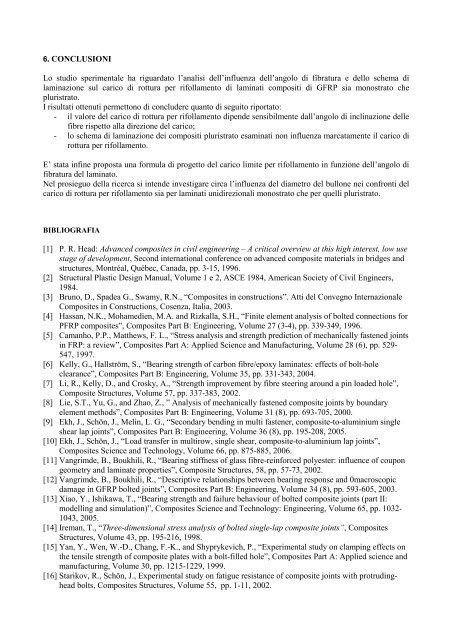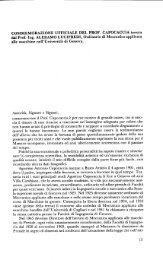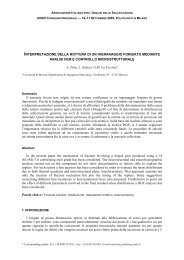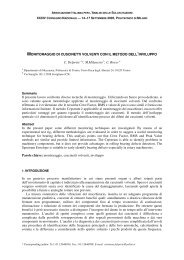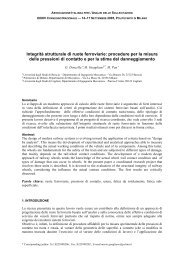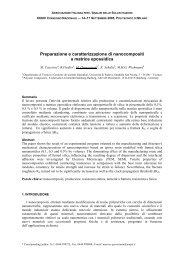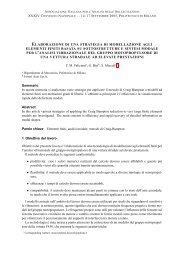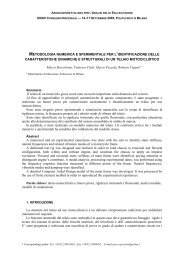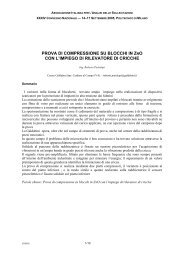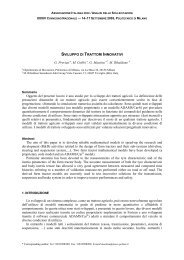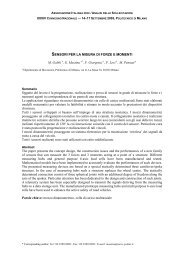sulla rottura per rifollamento di laminati compositi pluristrato - AIAS
sulla rottura per rifollamento di laminati compositi pluristrato - AIAS
sulla rottura per rifollamento di laminati compositi pluristrato - AIAS
Create successful ePaper yourself
Turn your PDF publications into a flip-book with our unique Google optimized e-Paper software.
6. CONCLUSIONI<br />
Lo stu<strong>di</strong>o s<strong>per</strong>imentale ha riguardato l’analisi dell’influenza dell’angolo <strong>di</strong> fibratura e dello schema <strong>di</strong><br />
laminazione sul carico <strong>di</strong> <strong>rottura</strong> <strong>per</strong> <strong>rifollamento</strong> <strong>di</strong> <strong>laminati</strong> <strong>compositi</strong> <strong>di</strong> GFRP sia monostrato che<br />
<strong>pluristrato</strong>.<br />
I risultati ottenuti <strong>per</strong>mettono <strong>di</strong> concludere quanto <strong>di</strong> seguito riportato:<br />
- il valore del carico <strong>di</strong> <strong>rottura</strong> <strong>per</strong> <strong>rifollamento</strong> <strong>di</strong>pende sensibilmente dall’angolo <strong>di</strong> inclinazione delle<br />
fibre rispetto alla <strong>di</strong>rezione del carico;<br />
- lo schema <strong>di</strong> laminazione dei <strong>compositi</strong> <strong>pluristrato</strong> esaminati non influenza marcatamente il carico <strong>di</strong><br />
<strong>rottura</strong> <strong>per</strong> <strong>rifollamento</strong>.<br />
E’ stata infine proposta una formula <strong>di</strong> progetto del carico limite <strong>per</strong> <strong>rifollamento</strong> in funzione dell’angolo <strong>di</strong><br />
fibratura del laminato.<br />
Nel prosieguo della ricerca si intende investigare circa l’influenza del <strong>di</strong>ametro del bullone nei confronti del<br />
carico <strong>di</strong> <strong>rottura</strong> <strong>per</strong> <strong>rifollamento</strong> sia <strong>per</strong> <strong>laminati</strong> uni<strong>di</strong>rezionali monostrato che <strong>per</strong> quelli <strong>pluristrato</strong>.<br />
BIBLIOGRAFIA<br />
[1] P. R. Head: Advanced composites in civil engineering – A critical overview at this high interest, low use<br />
stage of development, Second international conference on advanced composite materials in bridges and<br />
structures, Montréal, Québec, Canada, pp. 3-15, 1996.<br />
[2] Structural Plastic Design Manual, Volume 1 e 2, ASCE 1984, American Society of Civil Engineers,<br />
1984.<br />
[3] Bruno, D., Spadea G., Swamy, R.N., “Composites in constructions”. Atti del Convegno Internazionale<br />
Composites in Constructions, Cosenza, Italia, 2003.<br />
[4] Hassan, N.K., Mohame<strong>di</strong>en, M.A. and Rizkalla, S.H., “Finite element analysis of bolted connections for<br />
PFRP composites”, Composites Part B: Engineering, Volume 27 (3-4), pp. 339-349, 1996.<br />
[5] Camanho, P.P., Matthews, F. L., “Stress analysis and strength pre<strong>di</strong>ction of mechanically fastened joints<br />
in FRP: a review”, Composites Part A: Applied Science and Manufacturing, Volume 28 (6), pp. 529-<br />
547, 1997.<br />
[6] Kelly, G., Hallström, S., “Bearing strength of carbon fibre/epoxy laminates: effects of bolt-hole<br />
clearance”, Composites Part B: Engineering, Volume 35, pp. 331-343, 2004.<br />
[7] Li, R., Kelly, D., and Crosky, A., “Strength improvement by fibre steering around a pin loaded hole”,<br />
Composite Structures, Volume 57, pp. 337-383, 2002.<br />
[8] Lie, S.T., Yu, G., and Zhao, Z., ” Analysis of mechanically fastened composite joints by boundary<br />
element methods”, Composites Part B: Engineering, Volume 31 (8), pp. 693-705, 2000.<br />
[9] Ekh, J., Schön, J., Melin, L. G., “Secondary ben<strong>di</strong>ng in multi fastener, composite-to-aluminium single<br />
shear lap joints”, Composites Part B: Engineering, Volume 36 (8), pp. 195-208, 2005.<br />
[10] Ekh, J., Schön, J., “Load transfer in multirow, single shear, composite-to-aluminium lap joints”,<br />
Composites Science and Technology, Volume 66, pp. 875-885, 2006.<br />
[11] Vangrimde, B., Boukhili, R., “Bearing stiffness of glass fibre-reinforced polyester: influence of coupon<br />
geometry and laminate pro<strong>per</strong>ties”, Composite Structures, 58, pp. 57-73, 2002.<br />
[12] Vangrimde, B., Boukhili, R., “Descriptive relationships between bearing response and 0macroscopic<br />
damage in GFRP bolted joints”, Composites Part B: Engineering, Volume 34 (8), pp. 593-605, 2003.<br />
[13] Xiao, Y., Ishikawa, T., “Bearing strength and failure behaviour of bolted composite joints (part II:<br />
modelling and simulation)”, Composites Science and Technology: Engineering, Volume 65, pp. 1032-<br />
1043, 2005.<br />
[14] Ireman, T., “Three-<strong>di</strong>mensional stress analysis of bolted single-lap composite joints”, Composites<br />
Structures, Volume 43, pp. 195-216, 1998.<br />
[15] Yan, Y., Wen, W.-D., Chang, F.-K., and Shyprykevich, P., “Ex<strong>per</strong>imental study on clamping effects on<br />
the tensile strength of composite plates with a bolt-filled hole”, Composites Part A: Applied science and<br />
manufacturing, Volume 30, pp. 1215-1229, 1999.<br />
[16] Starikov, R., Schön, J., Ex<strong>per</strong>imental study on fatigue resistance of composite joints with protru<strong>di</strong>nghead<br />
bolts, Composites Structures, Volume 55, pp. 1-11, 2002.


